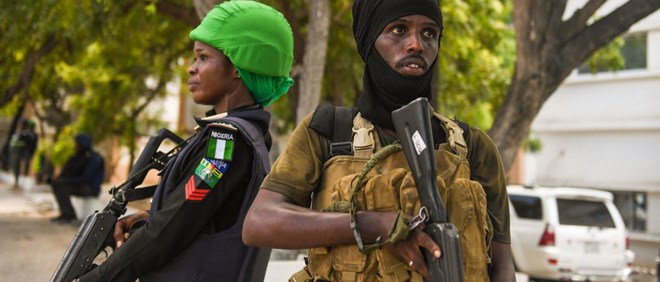
Saturday April 29, 2023
BY MERESSA K DESSU AND DAWIT YOHANNES

The fight against al-Shabaab has changed tack since Hassen Sheikh Mohamud became Somalia’s president last year. The more robust Somali-led approach is showing promising results. Supported by the African Union Transitional Mission in Somalia (ATMIS), the Somalia Security Forces’ (SSF) full-scale offensive has liberated vast territories from al-Shabaab.
However, ATMIS’ capacity to continue playing this role and stabilise Somalia is under threat. The mission is hard-pressed to implement its reconfigured mandate because it hasn’t received the necessary support. The solution lies in better resourcing ATMIS, fast-tracking preparations for the SSF to assume full security responsibilities, and rethinking ATMIS’ military and non-military roles in Somalia’s fast-changing security environment.
On 27 April, a summit of heads of states that contribute troops to ATMIS is expected to discuss the mission’s fate. The meeting in Uganda will review ATMIS’ achievements and its plan to reduce troops and exit Somalia in December 2024.
After much debate, ATMIS was reconfigured in April 2022 from the AU Mission in Somalia (AMISOM). Like its predecessor, ATMIS’ mandate includes degrading al-Shabaab. But it differs in its four-phased exit plan and its operational approach. ATMIS’ operational areas should align with the SSF’s geographic arrangements to create better connections and highly mobile units capable of robust offensives. This approach would enable hot pursuit strikes that deny al-Shabaab sanctuary and recover vital ground.
ATMIS gains include providing security during the last election and helping the SSF liberate vast territories from al-Shabaab. The Special Representative of the African Union (AU) Commission Chairperson and head of ATMIS, Ambassador Mohamed El-Amine Souef, said the mission had provided close air support, casualty and medical evacuation of SSF troops, intelligence and surveillance, indirect fire support, and ammunition, water, drugs, and field accommodation.
This new reality shows Somalis as the offensive force in the operation, with ATMIS more of a holding force in their areas, says Omar S Mahmood, International Crisis Group East Africa analyst.
However, ATMIS still doesn’t have mobile and agile forces due to insufficient capabilities, such as helicopters. An anonymous source said the United Nations (UN) approved support for 12 helicopters from troop-contributing countries, on condition that the mission’s headquarters command these assets. Discussions are ongoing to confirm whether contributing countries will agree, partly showing the broader need to enhance ATMIS’ command and control procedures.
The AU Peace and Security Council has repeatedly stressed the need to address this challenge, urging troop-contributing countries to adhere to ATMIS’ command and control structure.
ATMIS also struggles to maintain its forward operating bases, some of which must be closed to free up troops for the mobile component. It’s unclear how the mobile forces will be staffed, especially because the planned ATMIS drawdown will see 2 000 troops leave in June and 3 000 in September. Somalia’s forces will find it hard to take over some of these bases while fighting al-Shabaab and holding newly recovered areas.
The SSF also struggles to mobilise sufficient troops for an integrated, unified national force that can take over when ATMIS leaves. The AU has urged the fast-tracking of this process, but delays caused by the need to train Somali troops saw the first phase deadline postponed from 31 December 2022 to 30 June 2023. Egypt, Eritrea, Ethiopia and Uganda have committed to help train more Somali soldiers.
The Somalia-led approach has succeeded in degrading al-Shabaab and gradually taking over security responsibilities from ATMIS. To maintain momentum, these efforts should be supported and ATMIS’ major challenges dealt with. That requires action on various fronts, especially by the AU, Somali government, UN and European Union (EU). Other partners such as the United States, United Kingdom, United Arab Emirates, Turkey and frontline states (Ethiopia, Kenya and Djibouti) also have a role.
It is vital to rectify ATMIS’ persistent financial uncertainty, which undermines its operational ability. AU officials say the ‘more than 19 600-strong AU force won’t be able to function properly and help the Somalis unless that funding gap is filled.’ UN Under-Secretary-General Rosemary DiCarlo also warned that the lack of funding for ATMIS and Somalia posed a significant risk to the country’s security transition and could threaten hard-won gains.
The UN Security Council should consider the AU’s repeated calls to finance ATMIS through UN-assessed contributions. The EU, which has been the mission’s main funder, agrees. However the significant decline in contributions to ATMIS signals donor fatigue and wavering international support.
Addressing long-standing command and control challenges in ATMIS is a major priority for the AU and troop-contributing countries. The AU must fill vacant leadership positions, including force commander and other civilian posts. Together with Somalia’s government, the AU must also clarify the handover of security responsibilities from ATMIS to Somali forces. As the government tries to advance against al-Shabaab while simultaneously backfilling for ATMIS, the latter is suffering.
UN Security Council resolutions frequently state that there is no military solution for Somalia’s conflicts. Stabilising areas newly liberated from al-Shabaab’s control is key to averting a reversal of gains. Military offensives must be complemented by support for Somalia’s government and local actors who provide basic public services.
Neighbouring countries, which have hitherto focused on providing military support, could help provide basic infrastructure and public services, and foster community dialogues. The Intergovernmental Authority on Development could be a platform for exchanging civil servants from the region to support such initiatives.
The AU should consider other ways of providing non-military stabilisation support. February’s summit decided to use the AU Peace Fund to address ATMIS’ funding deficit, which could include boosting the mission’s civilian and police components. Such efforts are critical for building lasting peace in Somalia.